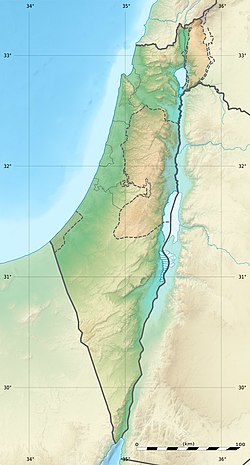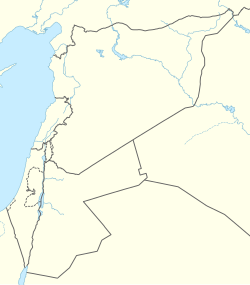Ancient City Ashdod
Ashdod (Philistine: 𐤀𐤔𐤃𐤃 *ʾašdūd; Hebrew: אַשְׁדּוֹד, romanized: ʾašdōḏ; Arabic: أسدود, romanized: ʾasdūd) or Azotus (Koinē Greek: Ἄζωτος, romanized: azōtos) was an ancient Levantine metropolis situated at Tel Ashdod, 'Mound of Ashdod', an archaeological site located a few kilometers south of the modern Ashdod in present-day Israel.
اسدود | |
 Philistine pottery at the Museum of Philistine culture, Ashdod, Israel | |
| Location | Ashdod, Israel |
|---|---|
| Region | Levant |
| Coordinates | 31°45′13″N 34°39′42″E / 31.75361°N 34.66167°E |
| Type | Ancient Levantine city |
The first documented urban settlement at Ashdod dates to the 17th century BCE, when it was a fortified Canaanite city, before being destroyed in the Bronze Age Collapse. During the Iron Age, it was one of the five cities of the Philistine pentapolis, and is mentioned 13 times in the Hebrew Bible. After being captured by Uzziah, it was briefly ruled by the Kingdom of Judah before changing hands between the Neo-Assyrian Empire, the Neo-Babylonian Empire and the later Achaemenid Empire.
Following the conquests of Alexander the Great, the city became known as Azotus. It was later incorporated into the Hasmonean kingdom. During the 1st century BCE, Pompey removed the city from Judean rule and annexed it to the Roman province of Syria.
Ashdod was a bishopric under Byzantine rule, but its importance diminished over the course of the medieval period.
In the Ottoman-era, this was the site of the former and now depopulated Palestinian village of Isdud. There was ongoing habitation at the site in the early modern period through to the 1948 Arab-Israeli War, when the then village of Isdud was depopulated when its inhabitants fled or were expelled. Today, the site is an archaeological site that is open to the public, with visible remains of Isdud and earlier historical ruins, thought to date back to the Philistine period.
Name evolution
The ancient Levantine settlement of Ashdod had many names. Its first attestation comes in the form of 11th century BCE Egyptian lists, where is it transcribed as "ísdd", which scholars have determined is derived from the Late Bronze Age Canaanite "’aṯdādu". This became "asdudu" or "asdūdu" in Assyrian records, "ašdudu" in Babylonian cuneiform and "ášdadi" in Ugaritic. The Hebrew "’ašdōd", or "Ashdod", is likewise believed to be derived from the Canaanite form.
In the Hellenistic period, the name of the settlement became "Azotus" in Greek and sometimes specifically "Azotus Mesogaias", literally "Inland Azotus", in contrast to Azotus Paralios, literally "Azotus-by-the-sea", or Ashdod-Yam in Hebrew. In the Early Muslim period, the geographer Ibn Khordadbeh referred to the city in the 9th century as "Azdud", echoing the pre-Hellenistic name. By the 16th century, it had lost its initial vowel to become just "Sdud", before regaining it by the 19th century as "Esdud" – a form of the settlement's name that changed little through to the 20th century "Isdud".
History
Bronze Age
Middle Bronze
The earliest major habitation in Ashdod dates to the 17th century BCE. Ashdod was fortified in MBIIC with a two-entryway city gate (similar to Shechem).
Late Bronze
Ashdod is first mentioned in written documents from Late Bronze Age Ugarit, which indicate that the city was a center of export for dyed woolen purple fabric and garments. At the end of the 13th century BCE, the Sea Peoples conquered and destroyed Ashdod. By the beginning of the 12th century BCE, the Philistines, generally thought to have been one of the Sea Peoples, ruled the city. During their reign, the city prospered and was a member of the Philistine Pentapolis ('five cities'), which included Ashkelon and Gaza on the coast and Ekron and Gath farther inland, in addition to Ashdod.
Iron Age through Persian period

In 950 BCE, Ashdod was destroyed during Pharaoh Siamun's conquest of the region. The city was not rebuilt until at least 815 BCE.
Overall, the city remained independent of Judean and Israelite rule up until the Hellenistic period.
Asdûdu led the revolt of Philistines, Judeans, Edomites, and Moabites against Assyria after expulsion of king Ahi-Miti, whom Sargon had installed instead of his brother Azuri. Gath (Gimtu) belonged to the kingdom of Ashdod at that time. Assyrian king Sargon II's commander-in-chief (turtanu), whom the King James Bible calls simply "Tartan" (Isaiah 20:1), regained control of Ashdod in 712/711 BCE and forced the usurper Yamani to flee. Sargon's general destroyed the city and exiled its residents, including some Israelites who were subsequently settled in Media and Elam.
Mitinti (Akkadian: 𒈪𒋾𒅔𒋾 mi-ti-in-ti; Philistine: 𐤌𐤕𐤕 *Mītīt or *Matīt) was king at the time of Sargon's son Sennacherib (r. 705–681 BCE), and Akhimilki in the reign of Sennacherib's son Esarhaddon (r. 681–669 BCE).
Psamtik I of Egypt (r. 664 – 610 BCE) is reported to have besieged the great city of "Azotus" for twenty-nine years (Herodotus, ii. 157); the biblical references to the remnant of Ashdod (Jeremiah 25:20; cf. Zephaniah 2:4) are interpreted as allusions to this event.
The city absorbed another blow in 605 BCE, when Nebuchadnezzar of Babylonia conquered it. Under Babylonian rule it was a province.
In 539 BCE the city was rebuilt by the Persians.
Hellenistic period
In 332 BCE the city was conquered in the wars of Alexander the Great.
During the Hellenistic period through to the late medieval period, the city was known to the Greeks as Αzotus (Greek: Άζωτος) or Azotus Mesogaios (literally "inland Azotus"). It was also known as Hippinos (literally "of the horsemen"), to the Romans.
Despite its location four miles (6 km) from the coast, Ptolemy (c. 90 – c. 168 CE) described the Hellenized city as a maritime city, as did Josephus in Antiquities.[non-primary source needed] Josephus also describes Ashdod as "in the inland parts".[non-primary source needed] This curious contradiction may refer to Ashdod's control of a separate harbor, called "Azotus Paralios", or Ashdod-on-the-Sea (παράλιος - "paralios", Greek for "on the coast").
Azotus prospered until the Maccabean Revolt, during which Judas Maccabeus took the city and "laid it waste".[non-primary source needed] His brother Jonathan Maccabaeus conquered it again in 147 BCE and destroyed the temple of Dagon associated with a Biblical story about the Philistine captivity of the Ark. During the rule of Alexander Jannaeus, Ashdod was part of his territory. The succession wars between Hyrcanus II and Aristobulus II wreaked destruction on Azotus.[non-primary source needed]
Roman period
Pompey restored the independence of Azotus, as he did with all Hellenising coastal cities.[non-primary source needed] A few years later, in 55 BCE, after more fighting, Roman general Gabinius helped rebuild Ashdod and several other cities left without protective walls. In 30 BCE Ashdod came under the rule of King Herod, who then bequeathed it to his sister Salome. By the time of the First Jewish–Roman War (66-70), there must have been a large enough Jewish presence in Ashdod for Vespasian to feel compelled to place a garrison in the city.
Byzantine period
During the Byzantine period, Azotus Paralios overshadowed its inland counterpart in size and importance. The 6th-century Madaba Map shows both under their respective names.
The prominence of Hellenised, then Christian Azotus continued until the 7th century.
The city was represented at the Council of Chalcedon by Heraclius of Azotus.
Early Muslim period
Azotus came under Muslim rule in the 7th century.
The geographer Ibn Khordadbeh (c. 820 – 912, Early Muslim period) referred to the inland city as "Azdud" and described it as a postal station between al-Ramla and Gaza.
Crusader and Mamluk periods
12-century Crusader church endowments and land deeds mention settlement in Azotum. During the Mamluk period, Isdud was a key village along the Cairo—Damascus road, which served as a center for rural religious and economic life.
Ottoman period
During the Ottoman period, the site was the location of a village, whose position on the Via Maris contributed to its importance. In 1596 CE, administered by nahiya ("subdistrict") of Gaza under the liwa' ("district") of Gaza, the population of Ashdod (named Sdud) numbered 75 households, about 413 persons, all Muslims. The villagers paid a fixed tax rate of 33,3% on wheat, barley, sesame and fruit crops, as well as goats and beehives; a total of 14,000 Akçe.

In the late nineteenth century, Isdud was described as a village spread across the eastern slope of a low hill, covered with gardens. A ruined khan stood southwest of the village. Its houses were one-storey high with walls and enclosures built of adobe brick. There were two main sources of water: a pond and a masonry well. Both were surrounded by groves of date-palm and fig-trees.
British Mandate

In the 1922 census of Palestine, conducted by the British Mandate authorities, Isdud had a population of 2,566 inhabitants; 2,555 Muslims and 11 Christians, where the Christians were all Catholics. The population increased in the 1931 census to 3,240; 3,238 Muslims and 2 Christians, in a total of 764 houses.
1948 Arab-Israeli War

The village of Isdud was occupied by the Egyptian army on May 29, 1948, and became the Egyptians' northernmost position during the 1948 Arab-Israeli War. While the Israelis failed to capture territory, and suffered heavy casualties, Egypt changed its strategy from offensive to defensive, thus halting their northward advance. Egyptian and Israeli forces clashed in the surrounding area, with the Egyptians being unable to hold the Ad Halom bridge over the Lachish River. Israeli forces surrounded the town during Operation Pleshet, and shelled and bombed it from the air. For three nights from 18 October the Israeli Air Force bombed Isdud and several other locations. Fearing encirclement, Egyptian forces retreated on October 28, 1948, and the majority of the residents fled. The 300 townspeople who remained were driven southwards by the Israel Defense Forces. The village was part of territory that was granted to Israel in the 1949 Armistice Agreements following the end of the war.
Biblical references
The Book of Nehemiah, referring to events in the 5th century BCE, mentions the Ashdodites and the speech of Ashdod, which half of the children from mixed families are described as adopting. Hugo Winckler explains the use of that name by the fact that Ashdod was the nearest of the Philistine cities to Jerusalem.
In the Joshua 11, Ashdod is listed among the cities assigned to the Tribe of Judah (Joshua 11:21-22)
In I Samuel 6:17 Ashdod is mentioned among the principal Philistine cities. After capturing the Ark of the covenant from the Israelites, the Philistines took it to Ashdod and placed it in the temple of Dagon. The next morning Dagon was found prostrate before the Ark; on being restored to his place, he was on the following morning again found prostrate and broken. The people of Ashdod were smitten with boils; a plague of mice was sent over the land (1 Samuel 6:5).
The 1st century CE Book of Acts refers to Azotus as the place in which Philip the Evangelist reappeared after he converted the Ethiopian eunuch to Christianity.
Archaeology
Ancient Ashdod has today become an archaeological site known as "Tel Ashdod", located a few kilometers south of the modern Israel city of Ashdod. It was excavated by archaeologists in nine seasons between 1962 and 1972. The effort was led during the first few years by David Noel Freedman of the Pittsburgh Theological Seminary and Moshe Dothan. The remaining seasons were headed by Dothan for the Israel Antiquities Authority.
References
This article uses material from the Wikipedia English article Ashdod (ancient city), which is released under the Creative Commons Attribution-ShareAlike 3.0 license ("CC BY-SA 3.0"); additional terms may apply (view authors). Content is available under CC BY-SA 4.0 unless otherwise noted. Images, videos and audio are available under their respective licenses.
®Wikipedia is a registered trademark of the Wiki Foundation, Inc. Wiki English (DUHOCTRUNGQUOC.VN) is an independent company and has no affiliation with Wiki Foundation.

